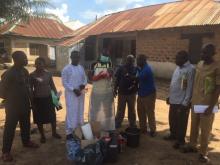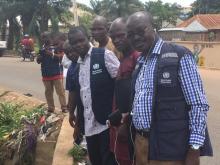World Environment Day – Nigeria intensifies environmental surveillance activities for Polio
Abuja, 12 June 2019 - As the` world continues to observe International Environment Day that was held on 5 June 2019, Nigeria is intensifying environmental surveillance activities for polio.
Traditionally, the presence of poliovirus is detected by surveillance systems focused on finding and reporting children who have specific polio symptoms such as acute flaccid paralysis. However, as only one in two hundred people infected with poliovirus show symptoms, the virus could circulate amongst children without being picked up by such methods. By testing sewage or wastewater contaminated with faeces, environmental surveillance provides a method of detecting the virus in thousands of individuals at once and to gather information about the presence of the virus even when symptoms are not evident.
Environmental surveillance for poliovirus first commenced in Nigeria in 2011 in Kano State to improve polio surveillance sensitivity.
“As at the end of 2018, Nigeria was implementing environmental surveillance in 78 collection sites, 41 Local Government Areas (LGAs) of 20 states and the Federal Capital Territory (FCT),” says Dr Kabir Yusuf, Polio surveillance team lead National Primary Health Care Development Agency (NPHCDA).
“Since most polio high-risk states are located in the northern part of the country, the majority of the environmental surveillance sites were set up in the northern states with only five States (Anambra, Enugu, Lagos, Osun and Rivers) in the southern part of the country having operational sites. However, following the present poliovirus epidemiology and feedback from collaborating partners, there have been calls for more concerted efforts to strengthen surveillance in the southern and adjoining states,” he adds.
To this end, Nigeria through the NPHCDA planned and executed a comprehensive strategy of expanding environmental surveillance in Benue, Cross River, Delta, Edo, Imo, Kogi, Kwara, Ogun and Oyo states in 2019.
The World Health Organization (WHO) accompanied this effort by offering training, data management, supervision and logistics support. WHO’s assistance to Nigeria in developing environmental surveillance in 2019 has been made possible with the financial support of the Bill and Melinda Gates Foundation, the United States Agency for International Development and the Government of Germany through the KfW development bank.
With this development, Nigeria is now implementing environmental surveillance in a total of 114 sites in 29 states and the FCT. Since the implementation of environmental surveillance activities in the South, a total of 775 samples have been collected, and 3 tested positive for wild poliovirus in 2012 (Lagos state).
Furthermore, “WHO supported the introduction of new technologies such as Digital Elevation Model (DEM) maps to greatly enhance environmental surveillance. Draining catchment area population estimates, draining slopes, and geo-locations are now easily depicted thereby improving site selection and sensitivity of the overall surveillance system“ states Dr Walla Abdullahi, Surveillance Officer, WHO Nigeria. This new technology enabled all the environmental sites in the country to be mapped, making it possible to see and appreciate the geo-spatial relationships between sites in any given state improving surveillance and polio risk assessment.
The last human wild polio virus case in Nigeria was seen on 21 August 2016 (Borno State) and the last Wild Poliovirus from an environmental sample was in 2014 (Kaduna State). Since then, WHO has been among the forefront in the fight against polio and is not relenting until the virus becomes history in Nigeria.





